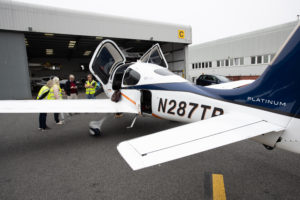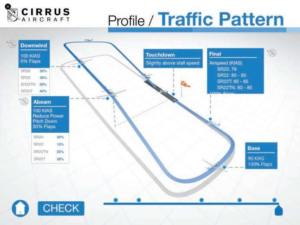 |
 |
Airspeeds for Normal Operation Weight= full fuel paxload <298kg
useful SR22 tips
| desc | veloc | |
|---|---|---|
| Vr (Flaps50%) | 80 |  |
| Vr obstacle 50% | 85 | |
| Cruise climb(SL) | 115-125 | |
| Vy (best rate SL) | 103 | |
| Vy (best rate 10k) | 102 | |
| Vx (best angle SL) | 88 | |
| Vy (best angle 10k) | 88 | |
| Approach (no flaps) | 90-95 | |
| Approach (flaps 50%) | 85-90 | |
| Approach (flaps 100%) | 80-85 | |
| Shortfield (flaps 100%) | 79 | |
| max turbulance (3400lbs) | 140 | |
| max turbulance (2900lbs) | 123 | |
| max demo Xwind | 21 | |
| Stall full flaps | 64 | |
| Stall clean | 74 | |
| Vo manoeuvring | 140 | |
| Vfe 50% flaps
|
150 |  |
| Vfe 100% flaps | 110 | |
| Vno Max structural cruising | 176- 150 |
|
| Vne Max speed | 205 | |
| Vpd Max parachute speed | 140 | |
| best glide | 89 |

Welcome
Welcome to the Cirrus family. Whether you are a new owner of an SR2X series aircraft or if you have the opportunity to fly one, we hope you’ll find this document informative and useful.
It is designed to answer many common questions about ownership and operation, but mainly from a cosmetic and aesthetic care standpoint.
As mentioned on the cover, it is NOT a P.O.H. nor a substitute for one; nor does it replace or in any way supersede any information provided in the P.O.H., the manufacturer’s guides or any Cirrus training materials. If you find anything in here that is contradictory, the official documentation will always take precedence.
Please take what you think is useful from this and skip over the rest!
When it comes to flying your aircraft the new interactive Cirrus iFOM or Flight Operations Manual is available as an iBook from Apple’s iBook store. On your iPad under the iBooks app, search for “Flight Operations Manual” published by Cirrus Aircraft. This is an amazing training tool that truly revolutionizes the flight training experience.
Naturally we’re very interested in your feedback too, so please do let us know if you have any suggestions to improve your flying experience…and of course feel free to tell your friends how much fun it is to fly a Cirrus!
A note for pilots/operators of previous generation aircraft.
At Cirrus Aircraft a key component to our success has been our continuous innovation from year to year. This document has been created for our very latest product offering, so while the majority of the sections herein apply to all our aircraft, you may see some features that are different from or not included in your aircraft. Nonetheless, we think you’ll still find this to be a valuable addition to your ownership experience.
Pre-Flight Inspection and Consumables
Make sure you remove these four items, if they are present: Cowl plugs, pitot tube cover, tie-down ropes, chocks. No gust lock is used in Cirrus aircraft because the trim cartridges are sufficient to prevent a gust from slamming the controls to the stops.
tend to “Rock Back” once
the engine starts,
If there is a canopy cover on, carefully remove it making note as to how to reinstall it. Be careful not to scratch the paint as you remove and/or reinstall the canopy cover. Whenever possible, store the canopy cover in its bag in the baggage compartment.
Use your best judgment if the cover is wet: A wet cover stored in its bag will go moldy; a wet cover simply put in the baggage compartment will get the interior wet; a wet cover left behind during a local flight could get wetter or dirtier, or could blow around on the ramp causing a serious safety hazard.